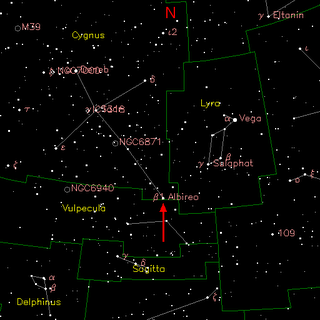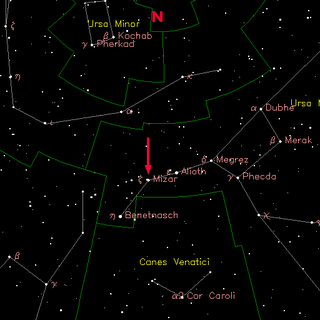(IMPORTANT UPDATE - Read this comment)
One of the most marvelous things about the night sky is the subtle variety in the stars, and the secrets some of these stars hide. Our eyes allow us to discern color, but our eyes were not created as precision astronomical instruments. Thank goodness for optics, for what we perceive frequently as single stars may in fact be two or more. We refer to these as multiple star systems.
One of the most marvelous things about the night sky is the subtle variety in the stars, and the secrets some of these stars hide. Our eyes allow us to discern color, but our eyes were not created as precision astronomical instruments. Thank goodness for optics, for what we perceive frequently as single stars may in fact be two or more. We refer to these as multiple star systems.
(image courtesy of "Heavens Above")
Let's look at three such star systems, moving from right to left (or west to east) on the chart above. These are Mizar and Alcor, Epsilon Lyra and Albireo.
Mizar and Alcor lie in the Big Dipper (or for our friends in the British Isles, the Plough), an asterism found within Ursa Major, the Great Bear.
Mizar and Alcor lie in the Big Dipper (or for our friends in the British Isles, the Plough), an asterism found within Ursa Major, the Great Bear.

(images courtesy of "Your Sky")
It used to be said that anyone who could be able to separate Mizar and Alcor with the naked eye would make good archers; in fact, this is probably just a legend, for anyone with fairly decent eyesight can do it. However, even though they appear to be near one another, they are in fact not a multiple star system at all; they are a chance alignment known as an "optical double". In order for it to be a true multiple star system, they have to be gravitationally bound to one another. Mizar, the brighter of the two, is 78 light years distant, while Alcor is 81. However, with a modest telescope, you'll find that Mizar appears to be two stars itself. Even this is deceptive, for each of those stars are in fact two stars a piece, true binary stars. The star we know as Mizar is in fact the collective light of four!
Next, we move to a rather interesting multiple star system, Epsilon Lyrae, located in Lyra, the Harp.


(images courtesy of "Your Sky")
Next, we move to a rather interesting multiple star system, Epsilon Lyrae, located in Lyra, the Harp.


(images courtesy of "Your Sky")
If your eyesight is particularly good, you can see that Epsilon Lyrae is two distinct stars, Epsilon Lyrae1 and 2. To really appreciate its beauty, though, you need a telescope, for even binoculars hide the truth. For Epsilon Lyrae is a "double-double" when seen through a modest telescope; a total of four stars are visible. There is still a secret hiding here, for one of those four stars is in fact another pair of stars. Unlike Alcor and Mizar, this is in fact a true multiple star system, with the main components taking hundreds of thousands of years to revolve around their center of gravity. The entire Epsilon Lyrae star system lies around 160 light years distance.
This brings us to the most striking object of our tour of multiple stars, Beta Cygni, commonly known as Albireo, in Cygnus the Swan.


This brings us to the most striking object of our tour of multiple stars, Beta Cygni, commonly known as Albireo, in Cygnus the Swan.


(images courtesy of "Your Sky")
Lying some 385 light years away, Albireo is perhaps one of the most beautiful objects in the summer sky if only for its contrast (incidentally, it is my personal favorite star). When viewed through a small telescope, this pale yellow star reveals itself to be two stars, one gold and the other sapphire... and they really look those colors! The differences in the two stars that make up Albireo make it one of the best objects to observe for the beginning astronomer. There are many stars out there like Albireo, but none as easy to find. As with the previous stars, there is more here than meets the eye (or telescope). The golden star, the brighter of the two, is actually a binary star, so a total of three stars make up this heavenly jewel. There is some debate as to whether or not the two main components of Albireo are even truly gravitationally bound, but if they are, their orbital period is perhaps as high as 100,000 years.
The Vagabond Astronomer will be set up in the parking lot of Books-A-Million in Mandarin the night of Saturday the 22 of July after 9 PM. I should have three scopes available, each one trained on an individual object, though I might be coaxed into turning one onto other celestial bodies. If you get a chance, do come by and visit as we look at these beautiful stars that truly have multiple personalities!
The Vagabond Astronomer will be set up in the parking lot of Books-A-Million in Mandarin the night of Saturday the 22 of July after 9 PM. I should have three scopes available, each one trained on an individual object, though I might be coaxed into turning one onto other celestial bodies. If you get a chance, do come by and visit as we look at these beautiful stars that truly have multiple personalities!


1 comment:
Let me tell you about a little thing known as weather. This evening, a line of thundershowers parked themselves on the west side of the St. John's River and proceeded to grow eastward (according to the NWS, the wind coming off the Gulf side of the state was stronger than the wind coming off the Atlantic). The result? By 8:00pm, we're socked in. So, this session is not happening. However, the information contained in the entry can still be used at any time. Feel free and do a little vagabonding yourself.
The Vagabond
Post a Comment